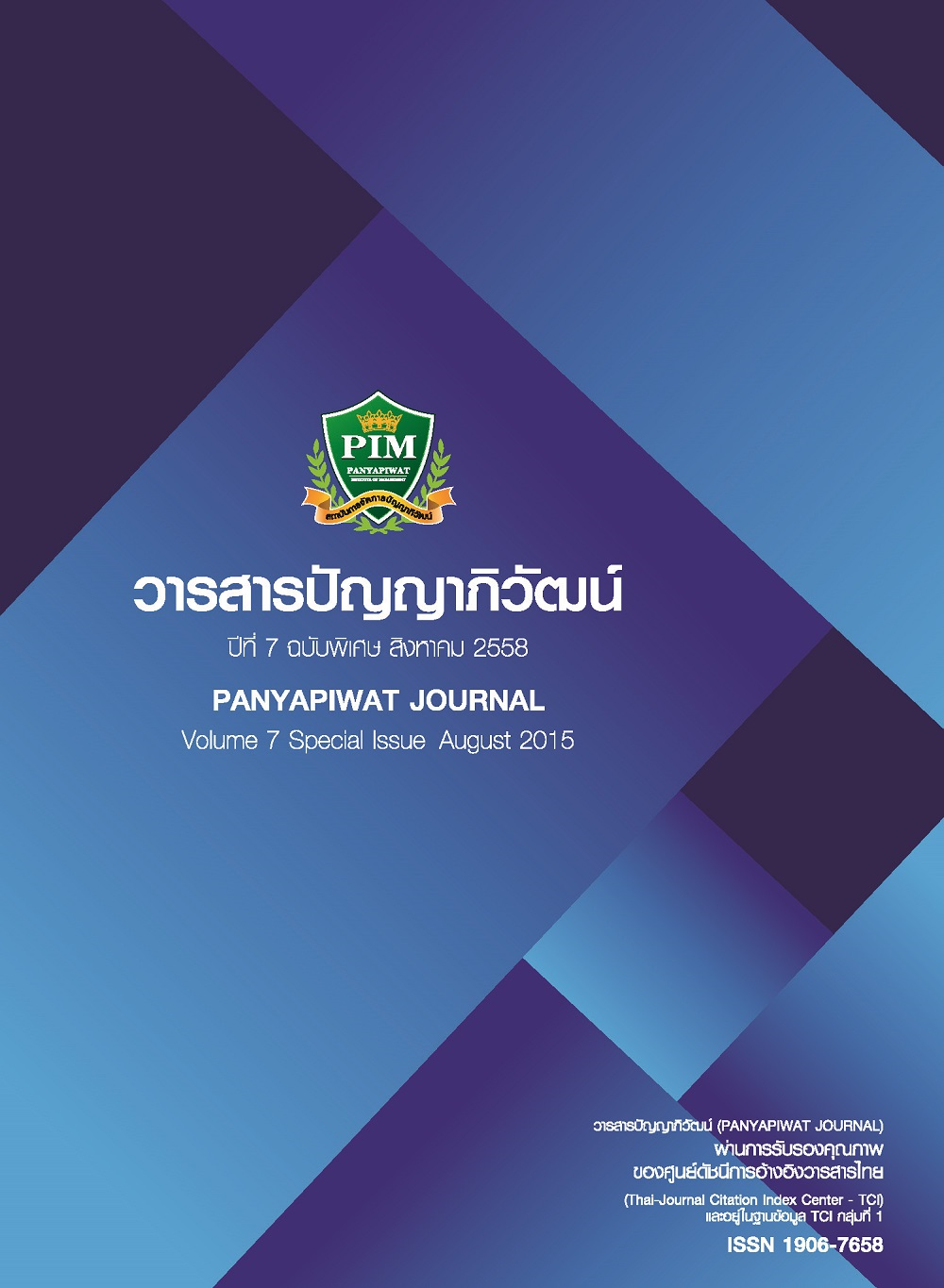ความผูกพันของพนักงานต่อองค์กร กรณีศึกษา บริษัท ธุรกิจรับชำระ XYZ จำกัด
Main Article Content
Abstract
ความผูกพันของพนักงานได้รับความนิยมมากในอดีตที่ผ่านมากว่า 20 ปี แต่ยังคงให้ความหมายและกรอบแนวความคิดได้ไม่ลงตัวเท่าใดนัก แม้ว่าส่วนใหญ่มีงานเขียนเป็นบทความวิจัยทางวิชาการให้เห็นบ้าง ช่องว่างดังกล่าวนี้มีผลทำให้หลายองค์กรพยายามหาแนวทางการสร้างความผูกพันของพนักงานต่อองค์กรในบริบทของตนเองเพื่อการพัฒนากลยุทธ์การบริหารทรัพยากรมนุษย์ขององค์กรให้มีความสามารถในการแข่งขัน บทความวิจัยนี้เป็นการศึกษาปัจจัยความผูกพันของพนักงานผ่านการวิเคราะห์ความเป็นมาขององค์กร โดยการวิจัยนี้มีวัตถุประสงค์ 2 ประการ คือ (1) เพื่อศึกษาระดับความผูกพันของพนักงานต่อองค์กร กรณีศึกษา บริษัท ธุรกิจรับชำระ XYZ จำกัด และ (2) เพื่อศึกษาแนวทางและจัดลำดับความสำคัญในการสร้างความผูกพันในองค์กร โดยใช้การทบทวนวรรณกรรมแบบบูรณาการกับการสัมภาษณ์เชิงลึกพนักงานของธุรกิจรับชำระแห่งหนึ่งเพื่อกำหนดกรอบแนวความคิด เครื่องมือเป็นแบบสอบถามแบบมาตราส่วนประมาณค่า 5 ระดับ มีค่าความเชื่อมั่นรวมที่ .968 เก็บข้อมูลจากพนักงานทั้งองค์กรจำนวน 157 คน พบว่า พนักงานมีระดับความผูกพันต่อองค์กรในระดับสูง มีระดับคะแนนเฉลี่ย 3.89 คิดเป็นร้อยละ 77.80 ระดับความผูกพันของพนักงานดังกล่าว มีผลต่อผลการปฏิบัติงานที่ระดับ .62 ทั้งระดับองค์กร ทีมงาน และบุคคล โดยที่ภาพความสำเร็จเกิดขึ้นอย่างชัดเจนที่ผลงานระดับองค์กรสูงสุดที่ .95 รองลงมา คือ ระดับทีมงาน .51 และสุดท้ายระดับบุคคล .47 แสดงให้เห็นถึงการรับรู้ของพนักงานว่า ผลสำเร็จของงานเกิดจากความร่วมมือกันเป็นทีมงาน ข้อค้นพบจากงานวิจัยนี้สะท้อนให้เห็นถึงความเฉพาะตัวของความผูกพันในแต่ละองค์กร สำหรับธุรกิจรับชำระนี้นำข้อค้นพบผลการวิจัยไปใช้เป็นแนวทางในการสร้างความผูกพันได้ตามลำดับดังนี้ (1) พัฒนาระบบความก้าวหน้าในงาน (2) พัฒนาระบบค่าตอบแทนสอดคล้องตามค่างาน (3) บริหารผลตอบแทนที่สอดคล้องกับลักษณะงาน (4) พัฒนาภาวะผู้นำ สร้างบรรยากาศความร่วมมือในการทำงาน และ (5) วางแผนกำลังคนให้สอดคล้องกับปริมาณงาน เพื่อเพิ่มขีดความสามารถให้รองรับกับการเติบโตทางธุรกิจรับชำระอย่างต่อเนื่อง
The term employee engagement has gained considerable popularity in the past more than 20 years. However, remains inconsistently defined and conceptualized. Although most have been written as academic research article, this gap has resulted in many organizations have been trying to create employee engagement in its own context to develop HRM strategies for business competitiveness. This paper explores the drivers of employee engagement with the organization analysis. The purposes of the study were: (1) To study employee engagement level of Bill Payment XYZ company and (2) to study a guideline and prioritize for employee engagement. The research was conducted by the integrated approach of literature review and in-depth interview to develop conceptual model. This research instrument was a five-rating scale questionnaire with the coefficient of reliability to .968. The data were collected by a set of questionnaire to sample of 157 employees. The results indicate that the Bill Payment XYZ company’s employees engagement was at high level of 3.89 or 77.80 percent and affected to the performance as total .62 (the beta weight of the organization, teams and individual were at .95 .51 and .47 respectively), demonstrating an awareness of the employee in team collaboration to achieve. This finding also reflected the specific employee engagement model in various businesses. This result was used to applied to the Bill Payment XYZ company as following : (1) to improve career development (2) to develop a suitable compensation system (3) to pay as job characteristic (4) to develop leadership and workplace climate and (5) to plan workforce by the workload, in order to enhance the capacity to support business growth continuously.
Article Details
I and co-author(s) certify that articles of this proposal had not yet been published and is not in the process of publication in journals or other published sources. I and co-author accept the rules of the manuscript consideration. Both agree that the editors have the right to consider and make recommendations to the appropriate source. With this rights offering articles that have been published to Panyapiwat Institute of Management. If there is a claim of copyright infringement on the part of the text or graphics that appear in the article. I and co-author(s) agree on sole responsibility.
References
ณัช อุษาคณารักษ์. (2554). เส้นทางสร้างความผูกพันของพนักงาน. สืบค้นเมื่อ 19 กรกฎาคม 2557, จาก http://www.hrcenter.co.th/index.php?module=columns_detail&ColumnID=994
ธุรกิจรับชำระ. (2557). เอกสารแนะนำธุรกิจรับชำระ. กรุงเทพฯ: สำนักทรัพยากรบุคคล บริษัท ธุรกิจรับชำระ XYZ จำกัด.
สถาบันเพิ่มผลผลิตแห่งชาติ. (2558). เกณฑ์รางวัลคุณภาพแห่งชาติ. สืบค้นเมื่อ 9 กุมภาพันธ์ 2558, จาก http://www.ftpi.or.th
De Lacy, C. J. (2009). Employee Engagement: The Development of a Three Dimensional Model of Engagement and Exploration of its Relationship with affective Leader Behaviors. A Research Paper for Master of Business, School of Management Queensland University of Technology.
Heskett, J. L., Jones, T. O., Loveman, G. W., Sasser, W. E. & Schlesinger, L. A. (2008). Putting the service-profit chain to work. Harvard Business Review, 86, 118-129.
Macey, W. H., Schneider, B., Barbera, K. M. & Young, S. A. (2009). Employee Engagement. Oxford UK: Wiley - Blackwell.
Macey, W. H., Schneider, B., Barbera, K. M., & Young, S. A. (2011). Employee engagement: Tools for analysis, practice, and competitive advantage. Talent Management Essentials, 31.
Maslow, A. H. (1943). A theory of human motivation. Psychological review, 50(4), 370-396.
PIM HR Excellence Center. (2557). Oversea HR Management. เอกสารประกอบการสัมมนา หลักสูตร Chief People Officer # 4. สถาบันการจัดการปัญญาภิวัฒน์. นนทบุรี.
Robertson-Smith, G. & Markwick, C. (2009). Employee Engagement: A Review of Current Thinking. Institute for Employment Studies.
Sparrow, P. & Balain, S. (2010). 24 Engaging HR strategists: Do the logics match the realities?. Handbook of employee engagement: Perspectives, issues, research and practice, 283.
Translated Thai References
Bill Payment XYZ Company. (2557). Bill Payment business introduction. Bangkok: Human Resource Department. [in Thai]
PIM HR Excellence Center. (2557). Oversea HR Management. Chief People Officer Program # 4 Handout. Panyapiwat Institute of Management. Nonthaburi. [in Thai]
Thailand Productivity Institute. (2015). Thailand Quality Award. Retrieved February 9, 2015, from http://www.ftpi.or.th [in Thai]
Usakanarak, N. (2011). Employee Engagement Roadmap. Retrieved July 19, 2014, from http://www.hrcenter.co.th/index.php?module=columns_detail&ColumnID=994 [in Thai]


